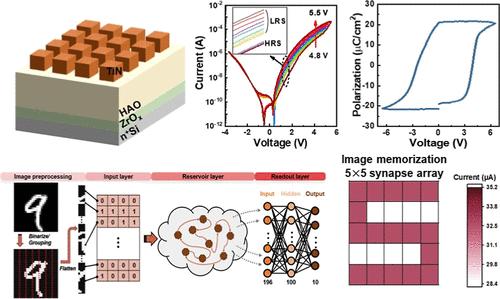当前位置:
X-MOL 学术
›
ACS Appl. Mater. Interfaces
›
论文详情
Our official English website, www.x-mol.net, welcomes your
feedback! (Note: you will need to create a separate account there.)
Reservoir Computing System with Diverse Input Patterns in HfAlO-Based Ferroelectric Memristor
ACS Applied Materials & Interfaces ( IF 8.3 ) Pub Date : 2024-11-19 , DOI: 10.1021/acsami.4c14910 Dongyeol Ju, Minseo Noh, Gimun Kim, Yongjin Park, Sejoon Lee, Sungjun Kim
ACS Applied Materials & Interfaces ( IF 8.3 ) Pub Date : 2024-11-19 , DOI: 10.1021/acsami.4c14910 Dongyeol Ju, Minseo Noh, Gimun Kim, Yongjin Park, Sejoon Lee, Sungjun Kim

|
Ferroelectric memristors, particularly those based on hafnia, are gaining attention as potential candidates for neuromorphic computing. These devices offer advantages over perovskite-based ferroelectric memristors owing to their simpler structures, compatibility with complementary metal-oxide semiconductor technology, and low-power consumption characteristics. Additionally, improvements in ferroelectric memristor’s performance, such as enhancing tunneling electro resistance (TER) and polarization retention, can be achieved using methods like aluminum doping and insulating film deposition. In this study, we implement a physical reservoir computing (RC) system utilizing the metal-ferroelectric-insulator–semiconductor-structured ferroelectric memristor based on Al-doped HfO2 as an artificial synapse. Specifically, we ensure the universality and diversity of the system by experimentally demonstrating a robust reservoir layer capable of handling various types of input pulses. To utilize the ferroelectric memristor in the reservoir layer of the RC system, we employ partial polarization switching of ferroelectric materials. We measure the retention loss characteristics of the device for pulse amplitude, interval, and width, and quantify the time constant values by fitting them to a stretched exponential function. Additionally, we validate the suitability of the fabricated device as an artificial synapse by mimicking various short-term plasticity functions of biological synapses. Furthermore, we experimentally demonstrate various applications related to learning and memory of the brain, such as image training and Pavlov’s experiment, utilizing the short-term memory characteristics of the fabricated device. Lastly, we evaluate the robustness of the RC system under various input conditions by employing the fabricated device as a reservoir layer.
中文翻译:

HfAlO 基铁电存储器中具有多种输入模式的储层计算系统
铁电忆阻器,尤其是那些基于 hafnia 的忆阻器,作为神经形态计算的潜在候选者而受到关注。这些器件具有比钙钛矿基铁电忆阻器更简单的结构、与互补金属氧化物半导体技术的兼容性以及低功耗特性,因此具有优势。此外,使用铝掺杂和绝缘膜沉积等方法可以改善铁电忆阻器的性能,例如增强隧穿电阻 (TER) 和极化保持。在这项研究中,我们利用基于 Al掺杂 HfO2 的金属-铁电-绝缘体-半导体结构的铁电忆阻器作为人工突触,实现了一个物理储层计算 (RC) 系统。具体来说,我们通过实验证明能够处理各种类型输入脉冲的稳健储层来确保系统的通用性和多样性。为了在 RC 系统的储层中利用铁电忆阻器,我们采用了铁电材料的部分极化开关。我们测量器件的脉冲幅度、间隔和宽度的保留损耗特性,并通过将它们拟合到拉伸指数函数来量化时间常数值。此外,我们通过模拟生物突触的各种短期可塑性功能来验证所制造的装置作为人工突触的适用性。此外,我们实验演示了与大脑学习和记忆相关的各种应用,例如图像训练和巴甫洛夫实验,利用所制造设备的短期记忆特性。 最后,我们通过将制造的器件用作储层来评估 RC 系统在各种输入条件下的鲁棒性。
更新日期:2024-11-19
中文翻译:

HfAlO 基铁电存储器中具有多种输入模式的储层计算系统
铁电忆阻器,尤其是那些基于 hafnia 的忆阻器,作为神经形态计算的潜在候选者而受到关注。这些器件具有比钙钛矿基铁电忆阻器更简单的结构、与互补金属氧化物半导体技术的兼容性以及低功耗特性,因此具有优势。此外,使用铝掺杂和绝缘膜沉积等方法可以改善铁电忆阻器的性能,例如增强隧穿电阻 (TER) 和极化保持。在这项研究中,我们利用基于 Al掺杂 HfO2 的金属-铁电-绝缘体-半导体结构的铁电忆阻器作为人工突触,实现了一个物理储层计算 (RC) 系统。具体来说,我们通过实验证明能够处理各种类型输入脉冲的稳健储层来确保系统的通用性和多样性。为了在 RC 系统的储层中利用铁电忆阻器,我们采用了铁电材料的部分极化开关。我们测量器件的脉冲幅度、间隔和宽度的保留损耗特性,并通过将它们拟合到拉伸指数函数来量化时间常数值。此外,我们通过模拟生物突触的各种短期可塑性功能来验证所制造的装置作为人工突触的适用性。此外,我们实验演示了与大脑学习和记忆相关的各种应用,例如图像训练和巴甫洛夫实验,利用所制造设备的短期记忆特性。 最后,我们通过将制造的器件用作储层来评估 RC 系统在各种输入条件下的鲁棒性。


















































 京公网安备 11010802027423号
京公网安备 11010802027423号